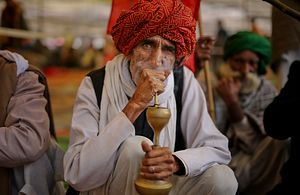Sanjay Sathe is an onion farmer in western India. In 2010, he met former U.S. President Barack Obama, who was visiting the country. Sathe was chosen to be part of a delegation of progressive farmers. This year, his farm produced 750 kilograms of onions, for which he earned only 1,064 Indian rupees ($15). He sent the earnings to Indian Prime Minister Narendra Modi in an act of protest; it cost him a further Rs 54 for the transfer. This was his way of protesting against the dismal condition of agriculture in India.
About 100,000 others like Sathe instead marched to the Indian Parliament last week. The smog in New Delhi was replaced with a reddened hue from the flags bearing a hammer and sickle, as women and men from across the country walked, in spite of their blistered feet and their dry mouths, their resolve steely.
From across India, they marched, claiming space and attention, to demand a dedicated 21-day session in Parliament to discuss the agrarian crisis that has engulfed India. This was a show of democracy – and discipline – through the efforts of a coalition of 200 large and small farmer groups. Farmers spent their own money to get this far. Those from Madhya Pradesh cast their votes in the Assembly elections in their home state and rushed to take the train. Almost everyone carried rice and lentils to feed themselves; they knew better than to expect anything from the big city where they would be perceived as a traffic inconvenience.
Their demands were clear, and boiled down to one point: the implementation of the recommendations of the National Commission on Farmers (NCF), which has comprehensively captured the systemic issues that have been derailing the sustainability of agriculture, and suggested steps to make it more profitable and cost competitive. It suggests the provision of a minimum support price that would secure small farmers when even the market prices fall drastically. Another key demand of the farmers has been the waiver of loans taken for sustaining their livelihood. Debt from such loans has long been one of the primary reasons pushing thousands to drink pesticide.
The agrarian crisis has plunged India’s farmers into a whirlpool of misery. Over 300,000 farmers have ended their own lives in the last two decades. Nearly 15 million farmers ditched the plow between 1991 and 2011. A 2014 survey revealed that 76 percent of farmers wanted to give up their occupation. The fallout of this has been the mass exodus of rural India into cities, seeking jobs that are unavailable and below dignity. For the first time in a nearly a century, urban India recorded a higher population, at 91 million, than rural India (90.6 million).
For those who continue to till the land that has been going barren with chemical fertilizers, using water that has fallen so deep into the ground that it brings along fluoride, recent catastrophic economic impositions like demonetization have led to simmering anger across the country. The rural guarantee scheme has been laying fractured; forests maintained by indigenous peoples have been turned into gated industrial zones. And farmers have learned that nobody’s been listening all this while.
The storm began to gather sometime last year, with farmers collectivizing themselves. One protest in central India that turned bloody catapulted the formation of the All India Kisan Sangharsh Coordination Committee. Along with another coalition, it began to push for institutional agrarian reforms. Several meetings were organized across the country, with an eye toward finalizing two bills to be tabled in Parliament: one on the minimum support price, and the other on freedom from indebtedness.
Earlier this year, 40,000 farmers marched to India’s financial capital, Mumbai, and the state government, which was adamant on dismissing them as “urban Maoists,” was forced to enter into a dialogue. Middle-class Mumbai took note, and parachuted into the streets with food, water, sandals, and medical aid. The march was the impetus for farmers in the rest of the country to follow suit. They wore their pride of being the people who feed the nation; they celebrated their cultural identities for all to assert their presence and essence.
Last week’s momentum is one that the ruling BJP has to reckon with, as several states go into polls between now and 2019. Veteran journalist P. Sainath, who first wrote about the suicide of cotton farmers the same year when cotton was the hero of India’s first fashion week, has written that “the news media, while denouncing loan waiver appeals, won’t mention that corporates and businessmen account for the bulk of the non-performing assets drowning the banks.”
Even as #KisanMuktiMarch was trending on social media, and a video of a pomegranate farmer smashing his farm produce to the ground went viral, the farmers who marched still had to compete with the coverage of two celebrity weddings around the same time. When one journalist cynically asked a farmer why she had come to the city, the defiant woman replied, “Because you didn’t come to my village.”

































